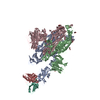+Search query
-Structure paper
| Title | Site of vulnerability on SARS-CoV-2 spike induces broadly protective antibody against antigenically distinct Omicron subvariants. |
|---|---|
| Journal, issue, pages | J Clin Invest, Vol. 133, Issue 8, Year 2023 |
| Publish date | Apr 17, 2023 |
 Authors Authors | Siriruk Changrob / Peter J Halfmann / Hejun Liu / Jonathan L Torres / Joshua J C McGrath / Gabriel Ozorowski / Lei Li / G Dewey Wilbanks / Makoto Kuroda / Tadashi Maemura / Min Huang / Nai-Ying Zheng / Hannah L Turner / Steven A Erickson / Yanbin Fu / Atsuhiro Yasuhara / Gagandeep Singh / Brian Monahan / Jacob Mauldin / Komal Srivastava / Viviana Simon / Florian Krammer / D Noah Sather / Andrew B Ward / Ian A Wilson / Yoshihiro Kawaoka / Patrick C Wilson /   |
| PubMed Abstract | The rapid evolution of the severe acute respiratory syndrome coronavirus 2 (SARS-CoV-2) Omicron variants has emphasized the need to identify antibodies with broad neutralizing capabilities to inform ...The rapid evolution of the severe acute respiratory syndrome coronavirus 2 (SARS-CoV-2) Omicron variants has emphasized the need to identify antibodies with broad neutralizing capabilities to inform future monoclonal therapies and vaccination strategies. Herein, we identified S728-1157, a broadly neutralizing antibody (bnAb) targeting the receptor-binding site (RBS) that was derived from an individual previously infected with WT SARS-CoV-2 prior to the spread of variants of concern (VOCs). S728-1157 demonstrated broad cross-neutralization of all dominant variants, including D614G, Beta, Delta, Kappa, Mu, and Omicron (BA.1/BA.2/BA.2.75/BA.4/BA.5/BL.1/XBB). Furthermore, S728-1157 protected hamsters against in vivo challenges with WT, Delta, and BA.1 viruses. Structural analysis showed that this antibody targets a class 1/RBS-A epitope in the receptor binding domain via multiple hydrophobic and polar interactions with its heavy chain complementarity determining region 3 (CDR-H3), in addition to common motifs in CDR-H1/CDR-H2 of class 1/RBS-A antibodies. Importantly, this epitope was more readily accessible in the open and prefusion state, or in the hexaproline (6P)-stabilized spike constructs, as compared with diproline (2P) constructs. Overall, S728-1157 demonstrates broad therapeutic potential and may inform target-driven vaccine designs against future SARS-CoV-2 variants. |
 External links External links |  J Clin Invest / J Clin Invest /  PubMed:36862518 / PubMed:36862518 /  PubMed Central PubMed Central |
| Methods | EM (single particle) |
| Resolution | 3.3 - 3.7 Å |
| Structure data |  EMDB-27112: S728-1157 IgG in complex with SARS-CoV-2-6P-Mut7 Spike protein (global refinement) EMDB-27113, PDB-8d0z: |
| Chemicals |  ChemComp-NAG: |
| Source |
|
 Keywords Keywords | VIRAL PROTEIN/IMMUNE SYSTEM / SARS-CoV-2 / cross-neutralizing antibody / neutralizing mAb / variants of concern / VIRAL PROTEIN-IMMUNE SYSTEM complex |
 Movie
Movie Controller
Controller Structure viewers
Structure viewers About Yorodumi Papers
About Yorodumi Papers





 homo sapiens (human)
homo sapiens (human)
